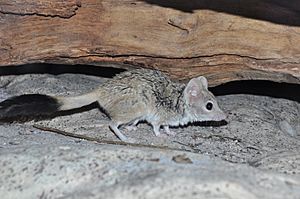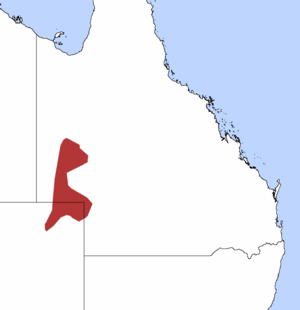Kowari facts for kids
Quick facts for kids Kowari |
|
|---|---|
 |
|
| Conservation status | |
| Scientific classification | |
| Genus: |
Dasyuroides
|
| Species: |
byrnei
|
| Subspecies | |
|
|
 |
|
| Distribution of the kowari | |
The kowari (Dasyuroides byrnei), also known by names like the brush-tailed marsupial rat or Kayer rat, is a small meat-eating marsupial. It lives in the dry grasslands and deserts of central Australia. This animal is the only species in its group, or genus.
About the Kowari
The kowari is a small animal, about 16.5 to 18 centimeters (6.5 to 7 inches) long. Its tail adds another 13 to 14 centimeters (5 to 5.5 inches) to its length. Kowaris mainly eat insects and spiders. They might also hunt small lizards, birds, or rodents. They are known as very active hunters.
Kowaris live in burrows, either alone or in small groups. They come out to hunt for food among grass tussocks. A special feature of the kowari is the brush of black hairs on the end of its tail. This brush goes all the way around the tail. Kowaris usually live for 3 to 6 years.
Kowari Reproduction
Kowaris have their babies in winter, from May to October. After being pregnant for about 32 days, a female kowari gives birth to 5 or 6 young.
Where Kowaris Live
The kowari lives in the stony desert areas of the Lake Eyre drainage basin. This includes parts of north-eastern South Australia and south-western Queensland. West of Lake Eyre, the number of kowaris is going down. They might even be completely gone from that area now.
Kowari Family Tree
The kowari is the only member of its specific group, called a genus. This genus is named Dasyuroides, which means it looks like Dasyurus, the quolls.
Sir Walter Baldwin Spencer first described the kowari in 1896. For a while, it was thought to be part of the Dasycercus genus. Spencer named the species after Patrick Michael Byrne. Byrne was a scientist and telegraph master at the Charlotte Waters telegraph station. He helped Spencer by collecting animal samples for many years. His work still helps scientists understand central Australian mammals today.
The common name "kowari" comes from the Diyari language. The kowari belongs to the family Dasyuridae. Its closest relative is the mulgara.
There are two types of kowari recognized:
- D. b. byrnei: Found in the north-eastern part of where kowaris live.
- D. b. pallidior: Found in the south-western part of where kowaris live.
See also
 In Spanish: Kowari para niños
In Spanish: Kowari para niños


